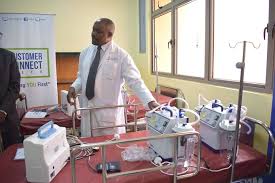
Vision:
To be the leader
in preserving the health and wellbeing of patients with kidney diseases in
Africa
Mission
To excel in the
practice of renal medicine through applying and generating clinical evidence
relevant to the needs of the people of Uganda
Values
Clinical
excellence, cultural relevance, cost consciousness, global competitiveness,
continuous quality improvement
1. Introduction
and Background
Chronic kidney disease (CKD) is an important
global public health problem, estimated to affect 10% (700 million) of the
world’s population by 2017. CKD risk has been mainly exacerbated by infectious
diseases such as HIV, Malaria and diarrheal diseases and their treatment, as
well as non-infectious diseases especially hypertension and diabetes, and
finally the use of potentially nephrotoxic traditional and non-traditional
medicines.
A recent survey conducted by the Uganda
Kidney Foundation, points to an increase in the kidney disease burden. Uganda
continues to grapple with non-communicable diseases, with over 25 percent (1 in
4 Ugandans) at risk of kidney diseases, while the condition continues to bite
in, many of the affected persons present to the health facilities very late with
advanced disease and hence limited options for relief or cure.
Poorly functioning kidneys prevent extra
water, waste, and other impurities from being removed from the body. These
therefore build up resulting in disease manifestations including: body
swelling, generalized itching, nausea and vomiting, bleeding tendencies and
eventually premature death. Kidneys also help control blood pressure and
regulate the levels of various chemical elements in the blood thus loss of
function will also manifest with related complications such as low blood
levels, and an increased risk of bones breaking if not promptly treated.
When the kidneys can’t perform these
functions due to disease or injury, dialysis can help keep the body running as
normally as possible. Without dialysis, salts and other waste products will
accumulate in the blood, poison the body, and damage other organs.
Dialysis is the process of removing excess
water and toxins from the blood in people whose kidneys can no longer perform
these functions naturally. Dialysis performs the function of the kidneys when
they have failed. Therefore, in that condition, a machine is employed to purify
the blood so it can balance fluids or does the work the kidney should have
done. It is in other simple terms what one could call kidney-life support.
2. Current
Situation
There are more than 350 sessions of
dialysis performed at Kiruddu National Referral Hospital on a weekly basis. The
hospital has been offering life-saving renal replacement therapy to the
patients since it started offering services to the public in 2016. The number
of dialysis machines started with was 19. With the increasing demand for the
hemodialysis services, the hospital managed to increase the dialysis machines
numbers to 30 in the year 2020. It is estimated the dialysis machines will need
to be doubled to 60 within five years.
The arrangement in which the hospital
acquired the dialysis machines is through placement. Meaning to say that the
hospital does not need to pay for the dialysis machines and services. All the
equipment related responsibilities are well taken care of by the professional
service providers. So that the hospital can concentrate on the medical services
provided to the patients (including the purchase of the consumables).
3. Goal
and Objective
To make the dialysis
center in Kiruddu National Referral Hospital a state-of-art dialysis center
with at least 60 dialysis machines, providing Hemodialysis, Hemodiafiltration
(HDF), and Hemoperfusion to the patients.
4. Achievements
made in the last three years
a.
Raised
the dialysis machine numbers from 19 to 30
b.
Reduced
infection rate on the ward
c.
Computerized
patient record management system
d.
Introduced
online HDF treatment
e.
Increased
the dialysis budget by lobbying stakeholders to appreciate the need for
increased funding for dialysis service
f.
Increased
the kidney disease clinic days from…. To….
g.
Introduced
quarterly dialysis RO water quality tests
h.
Availed
gowns, appropriate foot wear, bed sheets blankets, head wear to staff
i.
Conducting
regular laboratory (microbiologic and biochemical) quality checks on water for
dialysis
j.
Developed
checklists and SOPs to ensure safety of patients undergoing dialysis.